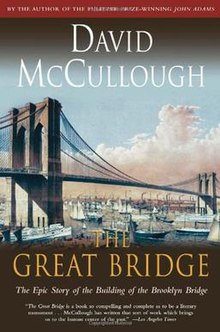
The Brooklyn Bridge is a hybrid cable-stayed/suspension bridge in New York City, spanning the East River between the boroughs of Manhattan and Brooklyn. Opened on May 24, 1883, the Brooklyn Bridge was the first fixed crossing of the East River. It was also the longest suspension bridge in the world at the time of its opening, with a main span of 1,595.5 feet (486.3 m) and a deck 127 ft (38.7 m) above mean high water. The span was originally called the New York and Brooklyn Bridge or the East River Bridge but was officially renamed the Brooklyn Bridge in 1915.
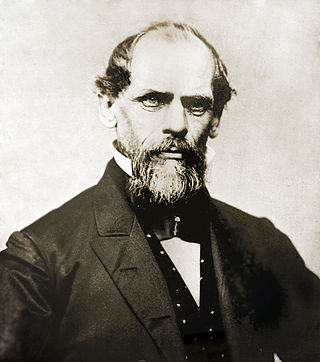
John Augustus Roebling was a German-born American civil engineer. He designed and built wire rope suspension bridges, in particular the Brooklyn Bridge, which has been designated as a National Historic Landmark and a National Historic Civil Engineering Landmark.
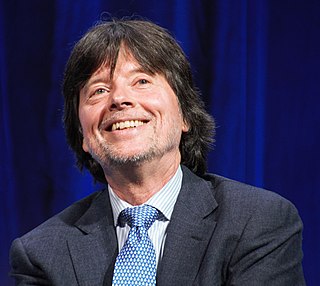
Kenneth Lauren Burns is an American filmmaker known for his documentary films and television series, many of which chronicle American history and culture. His work is often produced in association with WETA-TV and/or the National Endowment for the Humanities and distributed by PBS.

The Civil War is a 1990 American television documentary miniseries created by Ken Burns about the American Civil War. It was the first broadcast to air on PBS for five consecutive nights, from September 23 to 27, 1990.
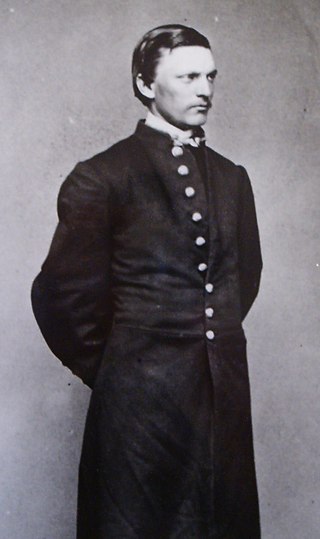
Washington Augustus Roebling was an American civil engineer who supervised the construction of the Brooklyn Bridge, designed by his father John A. Roebling. He served in the Union Army during the American Civil War as an officer at the Battle of Gettysburg.

Emily Warren Roebling was an engineer known for her contributions over a period of more than 10 years to the completion of the Brooklyn Bridge after her husband Washington Roebling developed caisson disease and became bedridden. She served as a liaison and supervisor of construction through communicating between her husband and on-site personnel. Her husband was the chief engineer during construction of the Brooklyn Bridge, which had been designed by his late father, John A. Roebling.
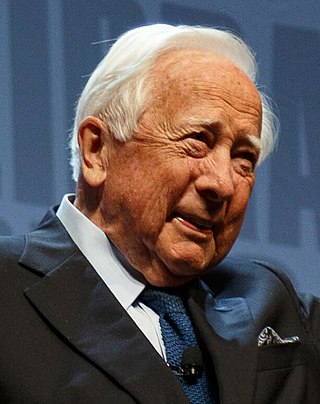
David Gaub McCullough was an American popular historian. He was a two-time winner of the Pulitzer Prize and the National Book Award. In 2006, he was given the Presidential Medal of Freedom, the United States' highest civilian award.

Steve Brodie was an American from Manhattan, New York City, who on July 23, 1886, claimed to have jumped off the Brooklyn Bridge and survived. The supposed jump, of which the veracity was disputed, gave Brodie publicity, a thriving saloon and a career as a performer. Prior to this, he was penniless, having lost significant sums of money on betting and race tracks.

The Niagara Falls Suspension Bridge stood from 1855 to 1877 across the Niagara River and was the world's first working railway suspension bridge. It spanned 825 feet (251 m) and stood 2.5 miles (4.0 km) downstream of Niagara Falls, where it connected Niagara Falls, Ontario to Niagara Falls, New York. Trains used the upper of its two decks, while pedestrians and carriages used the lower. The bridge was the idea of Canadian politicians, and it was built by an American company and a Canadian company. It was most commonly called the Suspension Bridge, although other names included Niagara Railway Suspension Bridge, Niagara Suspension Bridge, and its official American name of the International Suspension Bridge.

The Corner is a 2000 HBO drama television miniseries based on the nonfiction book The Corner: A Year in the Life of an Inner-City Neighborhood (1997) by David Simon and Ed Burns, and adapted for television by David Simon and David Mills. It premiered on HBO in the United States on April 16, 2000 and concluded its six-part run on May 21, 2000. The series was released on DVD on July 22, 2003. It won the Primetime Emmy Award for Outstanding Miniseries in 2000.

The Path Between the Seas: The Creation of the Panama Canal, 1870–1914 (1977) is a book by the American historian David McCullough, published by Simon & Schuster. The 698-page book contains 80 photographs, two maps and extensive source references. It won the U.S. National Book Award in History, the Francis Parkman Prize, the Samuel Eliot Morison Award, and the Cornelius Ryan Award.
Arthur W. Benson (c.1798–1889) was a president of Brooklyn Gas Light who developed the New York City suburbs of Bensonhurst and Montauk.
Brooklyn Bridge is a documentary film on the history of the Brooklyn Bridge. It was produced by Ken Burns, Roger Sherman, Buddy Squires, and Amy Stechler in 1981. The film included interviews with personalities such as The New York Times architectural critic Paul Goldberger and writer Arthur Miller plus film clips featuring Bugs Bunny and Frank Sinatra. The film was nominated for an Academy Award for Best Documentary Feature. It was narrated by historian David McCullough, who wrote the 1972 book the film was based on.
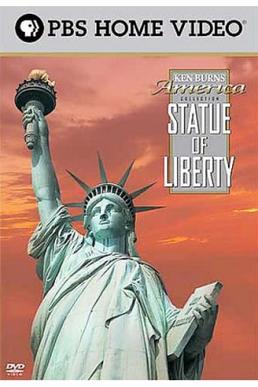
The Statue of Liberty is a 1985 American documentary film on the history of the Statue of Liberty. It was produced and directed by Ken Burns. The film, which first aired in October 1985, was narrated by historian David McCullough.
The Johnstown Flood is a 1989 American short documentary film directed by Charles Guggenheim about the Johnstown Flood. David McCullough, author of the 1968 book, The Johnstown Flood, hosted the film.
The Congress is a 1988 documentary film directed by the Emmy Award-winning director Ken Burns. The Florentine Films production, which focuses on the United States Congress, aired on PBS on March 20, 1989.
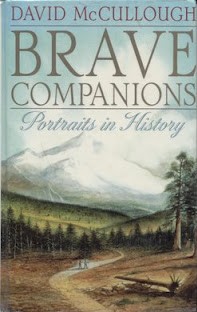
Brave Companions: Portraits in History is a 1991 book by the American historian David McCullough. The book consists of previously published essays, most of which are biographical portraits of a specific historical figure or group of figures. It is divided into five sections.
The Shakers: Hands to Work, Hearts to God is a 1984 documentary film by Ken Burns.
Paul Roebling was an American actor noted for Blue Thunder, Prince of the City and Carolina Skeletons. In the 1990 Ken Burns PBS documentary The Civil War, Roebling was the voice of Joshua Lawrence Chamberlain and read the famous letter written by Sullivan Ballou. He also directed his wife, Olga Bellin, in Zelda.
Sarah Burns is an American author, public speaker, and filmmaker. She is the author of The Central Park Five: A Chronicle of a City Wilding. She is also the co-producer and director for the documentary film The Central Park Five which she co-produced and directed with her husband David McMahon and her father Ken Burns.
